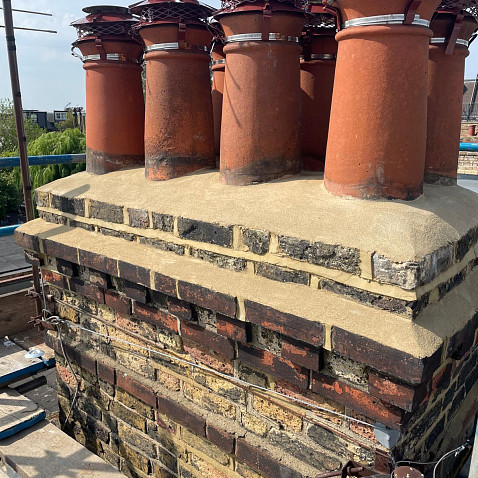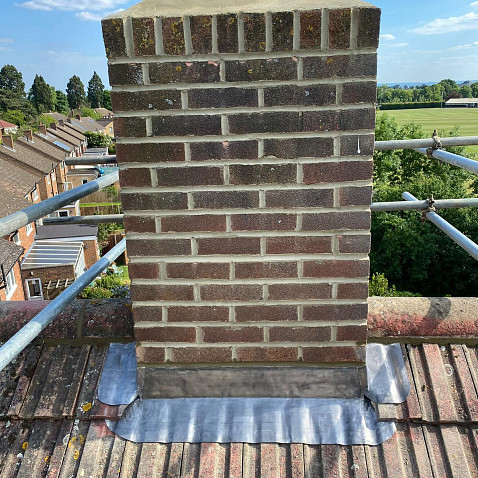A leaning chimney is more than just a cosmetic issue—it’s a serious structural concern that can lead to costly damage and safety hazards if not addressed promptly. Whether the tilt is minor or significant, a leaning chimney should always be evaluated by a professional to determine the cause and appropriate solution.
In this article, we’ll cover:
We also offer our services to help rebuild a leaning chimney.
We have certifications such as FSC and PEFC for timber, and every installation we undertake aligns with the BS 5534 Slating & Tiling regulation.
Book an installation

A chimney can start leaning for a variety of reasons, most of which stem from underlying structural or environmental issues. Below are the most common causes:
The most frequent reason chimneys lean is foundation movement or failure. If the chimney’s footing wasn’t poured properly, or if the soil beneath shifts or erodes, the structure can begin to tilt away from the home. Older homes are especially vulnerable, as many were built without a proper concrete footing under the chimney.
If a chimney was built with substandard materials or not anchored properly to the house, it may not have the structural integrity to stay upright over time. Inadequate reinforcement, poor mortar work, or incorrect height-to-width ratios can all lead to leaning.
Brick and mortar are constantly exposed to rain, snow, and temperature swings. Over time, this weathering causes mortar joints to crumble and bricks to loosen, weakening the structure and causing it to lean.
Changes in the ground beneath your chimney due to erosion, freeze-thaw cycles, poor drainage, or nearby construction can lead to uneven settling, especially if the soil wasn’t compacted properly during the home’s construction.
Even if your chimney has a footing, it may be too shallow, improperly reinforced, or made with low-quality concrete. A cracked or sinking footing can no longer support the chimney’s weight, leading to a visible lean.
Book an installation
Yes, absolutely. Even if the tilt seems small, a leaning chimney poses several serious risks:
A fully or partially collapsing chimney can cause severe damage to your roof, siding, gutters, and nearby structures. Worse, it poses a real threat of injury to anyone nearby.
When a chimney leans away from the home, it often pulls the flashing and masonry apart, creating a gap that allows water to infiltrate the home. Water intrusion can lead to mold, wood rot, and structural decay.
A leaning chimney can crack the flue liner, which is a key safety component. A damaged liner increases the risk of chimney fires and can allow dangerous gases like carbon monoxide to leak into your home.
Gaps and cracks caused by the tilt can allow birds, rodents, and insects to enter the chimney and, eventually, your home.
If you notice your chimney starting to lean, it’s important to act quickly. Here's what to expect from a professional evaluation and repair:
A certified chimney specialist or structural engineer will assess the extent of the tilt, the integrity of the footing, and the overall condition of the chimney. Tools like laser levels, crack gauges, and ground-penetrating radar may be used.
If the lean is caught early, it may be possible to stabilize the chimney using underpinning systems such as helical piers or push piers. These are inserted deep into the ground to bypass weak soil and anchor the chimney securely.
Specialized piering systems can not only stabilize but also gently lift and realign a leaning chimney to its original vertical position—if the structure is still sound.
If the brickwork or foundation is severely damaged, rebuilding part or all of the chimney may be necessary. Rebuilding to modern standards—including proper footings and damp-proof barriers—is the most permanent solution for some cases.
While older homes may have chimneys with a slight tilt that hasn’t changed in decades, even small movements should be monitored. In general:
Repairing a leaning chimney is not a DIY job. The weight of the structure, potential for collapse, and risk of further damage require experienced masons and structural specialists. Improper repairs can make the situation worse—or even dangerous.
If you’re dealing with a leaning chimney, don’t wait. Contact a qualified chimney repair company to assess the damage and recommend a safe, long-lasting fix.

A leaning chimney is more than an eyesore—it’s a structural red flag that needs immediate attention. From shifting soil to crumbling mortar and footing failure, many causes can be addressed, but only if caught early. With proper inspection and repair by trained professionals, your chimney can be safely restored, giving you peace of mind for years to come.
Need Help with a Leaning Chimney?
If you’ve noticed your chimney tilting or separating from your home, contact a certified chimney professional today to schedule a full inspection and get expert repair solutions tailored to your property.